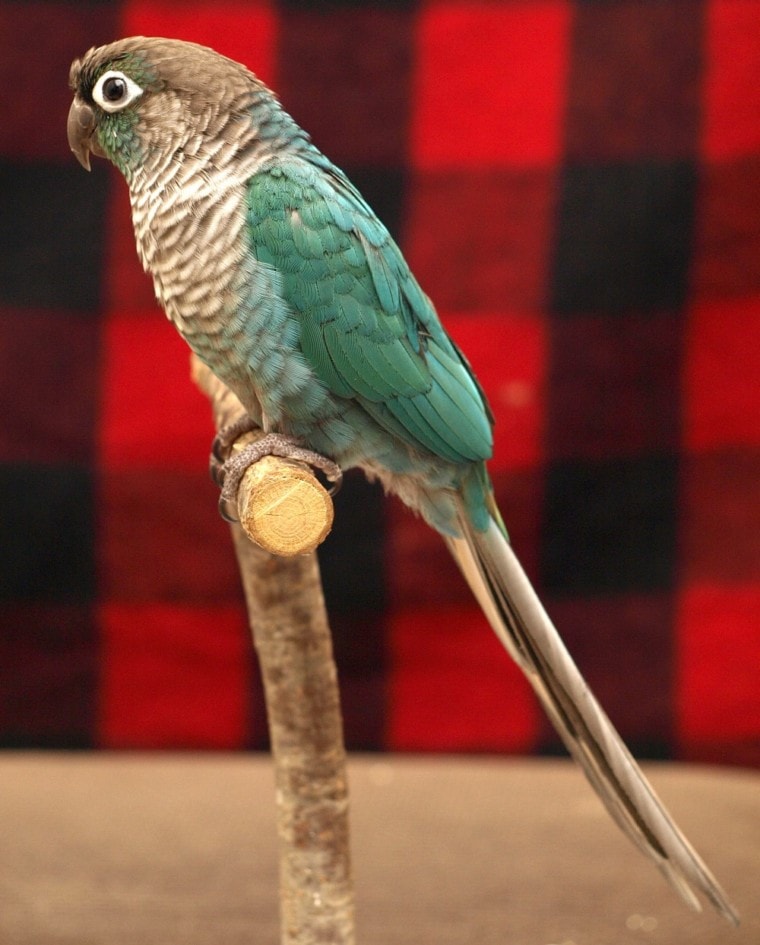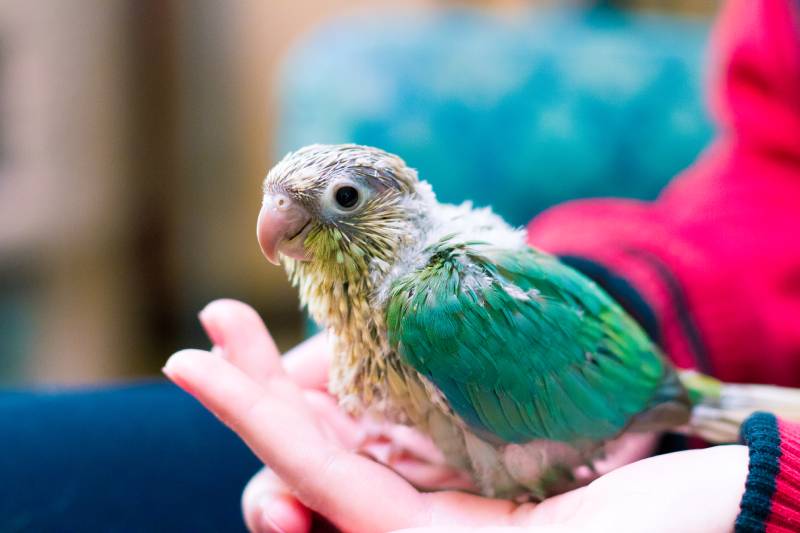
Click to Skip Ahead
What’s green, blue, and talks like you? One of the most popular pet birds in North America!
A Turquoise Green-Cheeked Conure bird is a medium-sized parrot that can grow up to 25 inches long from head to tail. They’re native to Central and South America, but they’ve been introduced worldwide. These birds are known for their beautiful colors and their ability to mimic human speech patterns.
The Turquoise Green-Cheeked Conure is an expensive but attractive option for a pet, and in this blog post, we’ll tell you everything you need to know about this little bird.
Species Overview

| Common Names: | Green-Cheeked Parrakeet |
| Scientific Name: | Pyrrhura molinae |
| Adult Size: | 10 inches |
| Life Expectancy: | 20–30 years |
Origin and History
The Green-Cheeked conure is also known as the Turquoise-Fronted Conure. They’re native to South America, where they live in groups of 6–20 birds. According to a small number of zoos that keep these birds as pets, it has some individuals have been recorded to reach 60 years if age in captivity!
Originally found in Bolivia and southern Brazil, the Turquoise Green-Cheeked Conure is now found in many countries, including Argentina, Belize, Bolivia, Brazil, Colombia, Ecuador, French Guiana, Guyana, Peru, and Suriname. It has even been introduced to Florida and Hawaii.
Its natural habitat includes forest edges with tall trees and thick vegetation. The Green-Cheeked Conure is also found in woodland and agricultural areas, and it can be seen at the edges of the rainforest. It’s not clear exactly how the bird got to Hawaii, but some believe that they were introduced by humans years ago.
Locals recognized these birds for many years, but they weren’t officially named until 1873. They were spotted by German explorer Alfred Brehm in the Bolivian jungle, who wrote about them in his journal and classified them under a new species name. In 1926, English ornithologist Philip Sclater gave the bird its current scientific name.
Turquoise Green-Cheeked Conure Colors and Markings

The head and chest of this parrot are turquoise green, which is their namesake. They have black beaks, lips, and ears, with a white spot on top of the upper mandible. The eyes are brown or orange-brown. Their chests are a mixture of vibrant greens, blues, and yellows. They have a dark stripe on their upper abdomens, which extends to the top of the chest. The back of this bird is green or brown with black feathers.
The feet of this species are gray or white, and the tail is bluish-black at the tips and more green near its base. The bottom of the tail is green or brown.
Where to Adopt or Buy a Turquoise Green-Cheeked Conure
These birds are quite rare and only available through particular breeders.
Feral populations have been found in Florida and Hawaii, but they’re scarce. If you find a wild-caught Green-Cheeked Conure while hiking or bird watching, consider reporting the sighting to your state wildlife organization. Not just because it’s illegal to keep one as a pet, but because of a small group of people, this species could die out if too many are caught.
If you plan to adopt or buy a Green-Cheeked Conure, you’ll want to make sure that it’s captive-bred and not wild-caught. If the breeder doesn’t know its origin, then avoid buying from them.
The average price for a regular Green-Cheeked Conure is around $450, and these birds are available in most pet stores. On top of adoption fees, you’ll need to budget for housing and food.
Final Thoughts
With all this new information, we hope you come to find the Turquoise Green-Cheeked conure an attractive and interesting option for a pet. It’s not cheap, but it is rare–and unique! All these qualities make the bird worth your while.
If you’re interested in learning more about other species of birds, just check out our blog on any number of different types that are right for your home or office. We’ll be happy to share everything we know with you, so feel free to ask us questions at any time!
Featured Image Credit: 2008-02-10 Uroko-vivi, Toumoto(愛鳥写真家 おぴ~とうもと), Wikimedia Commons, CC 3.0 International









